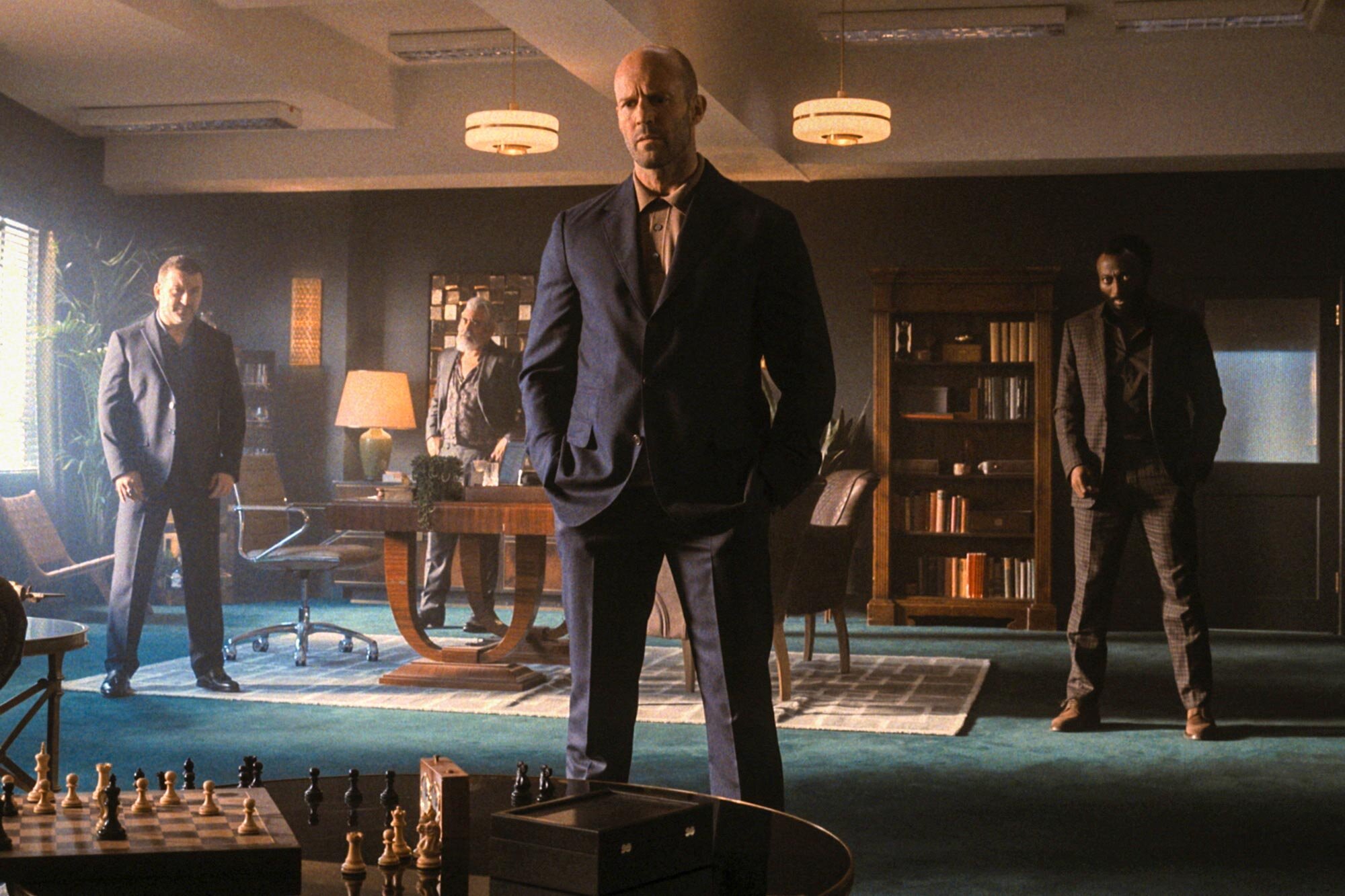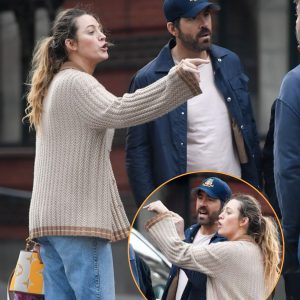A star vehicle for Jason Statham at his meanest, “Wrath of Man” is one of Guy Ritchie’s best-directed movies—and one of his most surprising, at least in terms of style and tone. Gone is the jumpy, busy, lighthearted, buzzed-bloke-in-a-pub-telling-you-a-tale vibe of film like “Snatch,” “RocknRolla,” “The Man from U.N.C.L.E.,” “King Arthur,” and the like. In its place is voluptuous darkness, so sinister that you may wonder if its main character is the devil himself.
This character is named Patrick “H” Hill (one letter removed from “Hell”). His coworkers at Los Angeles’ Fortico armored car company call him “H,” which sets him up to be sort of a Kafka character, a nearly nameless cog in a societal machine. H is a rookie on the job. He reads as a surly, socially inept, uncommunicative lump—he barely passes the driving and shooting tests, and his resting face is somewhere between brooding and seething—but his supervisor Bullet (Holt McCallany) hires him anyway because beggars can’t be choosers. Morale has been low ever since a daylight heist became a bloody public shootout that claimed multiple lives, including two Fortico guards.

Adapted from the 2004 French film “Le Convoyeur” (aka “Cash Truck”), and borrowing the basic outline of the story, “Wrath of Man” is a time-shifting neo-noir crime thriller, filled with tough, sometimes violent men: gangsters and former combat veterans, mostly, with a smattering of security guards and cops. Ritchie and co-screenwriters Ivan Atkinson and Marn Davies suggest that H could belong to any of those groups, or might be something else entirely. We instantly suspect he’s not the man he claims to be even if we haven’t seen the trailer (in H’s very first scene, somebody says his name and he replies a half-second later than he should). Then the film lets a couple of major characters suspect the same thing, and then a couple more, until it becomes a regular topic of discussion at Fortico, along with jokes about somebody on the team being an inside man for armored car robbers (which seems plausible, given how often their trucks are attacked).

From there until a third of the way through the story, Ritchie and Statham treat H as a blank screen upon which the imagination can project scenarios. We wonder who H really is and what he actually wants. And we wonder whether his precise response to another heist—shooting a bushel of robbers singlehandedly while crooks use Bullet as human shield and H’s partner, Boy Sweat Dave (Josh Hartnett) sits in the driver’s seat of the armored car, paralyzed with fear—is a harbinger of heroic deeds to come, or the opening salvo in an inside-man strategy that will reveal H as a monster of greed and bloodlust.
Then the movie takes us to a different time and place; and then, 15 minutes later, to another time and place; and then another, always giving us additional information about H that will likely negate whatever take you had. This is less of a self-consciously clever Quentin Tarantino-Guy Ritchie maneuver, and more in the poker-faced, un-ironic spirit of classic older films that inspired them, like “The Killing” and “The Killers” and “Criss Cross” (another armored car-focused crime thriller, remade by Steven Soderbergh as “The Underneath”). To avoid disclosing twists that delighted me (even when, in retrospect, I should’ve seen them coming) let’s say that each narrative shift (heralded by a white-on-black chapter title) widens the movie’s focus, until it becomes a panorama of sleaze and cruelty, democratically distributing its attention among a roster of men with faces that Humphrey Bogart could’ve punched.
It’s not a spoiler to say that H has a personal reason for what he’s doing at Fortico, and that every one of his actions, no matter how seemingly ill-advised, contributes to his mission, whether he’s baiting a coworker at a bar, threatening another employee at gunpoint into answering some questions, or staring just a bit too long at the wall of ID badges where Fortico employees clock in and out. His cell phone’s ring tone is a sample from Wagner’s “Ride of the Valkryies,” and there’s zero indication that H picked it because he thought it was funny. He looks like a guy who laughed four times in the 1990s and decided it wasn’t for him.

There’s a touch of Clint Eastwood’s hero-as-horror-movie-stalker characters in the film’s presentation of H—the ones that that gave the mayhem in “Dirty Harry,” “High Plains Drifter,” and “Pale Rider” a bitter aftertaste. He’s never really happy unless he’s torturing or 𝓀𝒾𝓁𝓁ing somebody that he thinks deserves to suffer pain, but even then, he doesn’t seem happy. He seems driven by a code and a sense of duty rather than by the raw emotions he ought to be feeling, based on what we come to know about him.
The Eastwood vibe is so strong that it makes the decision to cast Eastwood’s son Scott as a snotty psycho named Jan seem like critical commentary on cinema history. Ritchie might be the first director to find something uniquely malignant in the younger Eastwood’s screen presence, which is reminiscent of his dad in the pre-spaghetti Western era, before he figured out how to be a star. Jan oozes fratty entitlement, and his smirky, gum-chewing, rebel-without-a-grievance shallowness is central to his vileness. He’s the kind of crook who is specifically warned not to buy anything expensive after a heist, then gets himself a loft apartment and a $28,000 bike and seems offended when a colleague calls him out.
He’s just one more snake in the snake pit. There are three, maybe four major characters in this film that you’d briefly consider saving from a house fire. H and Jan aren’t on the list. Nor are Boy Sweat Dave or the ex-mercenaries Carlos (Laz Alonso), Sam (Raúl Castillo ) and Jackson (Jeffrey Donovan, whose decadent Mercury astronaut handsomeness is chef’s-kiss perfect), or a mysterious law enforcement bigwig known only as The King (Andy Garcia) who finds out that H is tearing through the underworld and decides to stand back and let him do his thing. “Let the painter paint,” he says, echoing one of the most quoted lines from the similarly nasty thriller “Man on Fire,” describing its vigilante hero: “Creasy’s art is death, and he’s about to paint his masterpiece.”
If there’s a problem with the movie, it’s that the blood-painter H is so mesmerizing—the kind of driven, merciless antihero who keeps you guessing as to whether he even has a soul to lose—that whenever “Wrath of Man” leaves him to flesh out the other characters, they can’t measure up because their badness is too legible. They want money, they want respect, they’re bored and need something to do, etc. They don’t enter the room and bring the smell of sulphur with them, like H.
You need just the right actor for such an innately ludicrous part. Statham is it. He’s always been a more versatile and game leading man than his lad-movie resume might indicate—whether he’s clowning it up in “Spy,” playing wisecracking Ahab to a giant prehistoric shark in “The Meg,” or embarking on a blood-soaked spiritual odyssey in Ritchie’s shoot-’em-up parable “Revolver,” he’s always got that economical, Old Hollywood movie star work ethic, giving viewers the information they need at the moment when they need it.
There aren’t many adjectives in his acting here. It’s a nouns-and-verbs star turn, like Eastwood and Charles Bronson in Sergio Leone’s Westerns, and Takeshi Kitano in his pre-millennia yakuza pictures. When H’s office manager, Terry (Eddie Marsan), says the new guy is “colder than a reptile,” it seems like an understatement. Ritchie and cinematographer Alan Stewart amplify Statham’s choices by treating his shaved dome and wood-carved face as sinister art objects, hiding his eyes in shadow as H processes bad news and giving his noggin the Colonel Kurtz globe-of-doom treatment.
More so than any other Ritchie film, you feel the presence of Evil in this one, in the capital-E, mythological or biblical sense, soul-rotting and innocence-𝓀𝒾𝓁𝓁ing, not “bad guy does bad things while laughing.” It’s not a horror film, but it’s horror-film adjacent. There’s even a shot from the point-of-view of a man in riot gear on a 𝓀𝒾𝓁𝓁ing spree, his labored breathing amplified by plexiglas and rubber. You could show “Wrath of Man” as part of a double feature with Ritchie’s “Revolver.” In one, Statham plays a morally compromised character whose endangered soul might still be saved. In the other, he plays a man who’s so far past that point that the affront that triggers his rampage plays less as an inexplicable catastrophe than as karmic payback for the toxic energy he’s pumped into the world.
Composer Christopher Benstead backs the film’s prowling and plan-making with a minor-key, seven-note theme that would be perfect for shots of Godzilla’s dorsal fins cutting through waves. It’s a brilliant bit of scoring that expresses a truth about H better than dialogue could. When Ritchie cuts to helicopter shots of armored trucks and getaway vehicles driving from point A to point B, Benstead’s motif repeats with variations until it seems like an incantation summoning dark forces.
Ritchie’s direction suits the movie’s stripped-down, practically elemental energy. As is always the case in a Ritchie picture, there’s some magisterial cross-cutting (by James Herbert), but it never feels busy or showy; it’s more about the inevitability, fatefulness even, of the forces that these characters have unleashed. The final third is one of those tour-de-force adventures in heist exposition where the exposition and the heist are folded together, and the movie keeps cutting from toy vehicles on a diorama to real ones on the street.
But the most memorable scenes are shot rather plainly by Ritchie’s standards, often in a single take, the camera gliding from character to character as they move through spaces and talk. It’s fun to watch a maximalist pare back like this, keeping it simple except when he needs to be a wizard who’s everywhere at once.
The completeness and sureness of the movie’s aesthetic is a joy to behold, even when the images capture human beings doing savage things. You don’t really root for anyone in this film. They are criminals engaged in contests of will. But the film is not a value-neutral exercise. There is an undertone of lament to a lot of the violent action. Every character made their bed and must lie it. More often than not, it’s a deathbed.
Now playing in theaters.





